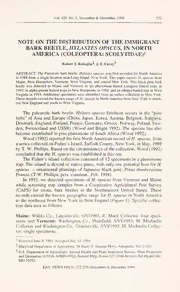
Note On The Distribution Of The Immigrant Bark Beetle, Hylastes opacus, In North america (Coleoptera, Scolytidae) PDF
Preview Note On The Distribution Of The Immigrant Bark Beetle, Hylastes opacus, In North america (Coleoptera, Scolytidae)
Vol. 105, No. 5, November&December, 1994 277 NOTE ON THE DISTRIBUTION OF THE IMMIGRANT BARK BEETLE, HYLASTES OPACUS, IN NORTH AMERICA (COLEOPTERA: SCOLYTIDAE)1 RobertJ.Rabaglia2,J.F.Cavey3 ABSTRACT: The Palearcticbark beetle,Hylastesopacus, wasfirstrecorded forNorth America in 1989 from a single location nearLong Island, New York. This paperreports //. opacus from Maine, New Hampshire, Vermont, West Virginia, and central New York. This black pine bark beetle was detected in Maine and Vermont in Ips pheromone-baited Lindgren funnel traps in 1993,inalpha-pinenebaitedtrapsin New Hampshitein 1994,andanethanolbaitedtrapin West Virginiain 1994. Additional specimens were identified from an earliercollection in New York. TheserecordsextendtheknownrangeofH. opacusin NorthAmericafromNew Yorkto north- emNewEnglandandsouthtoWestVirginia.. The palearctic bark beetle, Hylstes opacus Erichson occurs in the "pine belts" ofAsia and Europe (China, Japan, Korea, Austria, Belgium, Bulgaria, Denmark, England, Finland, France, Germany, Greece, Norway, Poland, Swe- den, Switzerland and USSR) (Wood and Bright 1992). The species has also become established in pine plantations ofSouth Africa (Wood 1992). Wood (1992) reported the first North American record ofH. opacus, from aseriescollectedon Fisher's Island, SuffolkCounty, New York, in May, 1989 by T. W. Phillips. Based on the circumstances ofthe collection, Wood (1992) concluded that the H. opacus was established at this site. The Fisher's island collection consisted of 12 specimens in a pheromone trap. The island is devoid ofnative pines, with only one potential host for H. - opacus ornamental plantings of Japanese black pine, Pinus thunbergiana Franco. (T.W. Phillips, pers. commun., Feb. 1994). In 1993, we detected specimens of H. opacus from Vermont and Maine while screening trap samples from a Cooperative Agricultural Pest Survey (CAPS) for exotic bark beetles in the Northeastern United States. These records extend the known geographic range for H. opacus in North America to the northeast from New York to New Engand (Figure 1). Specific collec- tion data area as follows: Maine: Waldo Co., Lincolnville, 6/V/1993, R. Mack Collector, four speci- mens and Vermont: Washington Co., Plainfield, 5/VI/1993, M. Michaelis Collectorand Washington Co., Graniteville, 3/VI/1993, M. Michaelis Collec- tor, single specimens. 1 ReceivedJune9, 1994. AcceptedJuly 12, 1994 2Maryland DepartmentofAgriculture, 50Harry S.Truman Pkwy, Annapolis, MD21401. 3U.S. Department ofAgriculture, Animal Healthand Plant Inspection Service, Plant Protection andQuarantine(USDA-APHIS-PPQ),Federal Bldg, Room625, 6506Belcrest Rd, Hyattsville, MD 20782. ENT. NEWS 105(5): 277-279, November& December 1994 278 ENTOMOLOGICALNEWS All collections were from Lindgren funnel traps baited with Ipslure (ips- dienol, methylbutanol andcis-verbenol). Specimens wereidentifiedusingBal- achowsky (1949) and by comparison to European material in the Eggers Collection at the U.S. National Museum (USNM). Afterreviewing the new England specimens, the seniorauthoridentified a seriesof//, opacushecollectedfromacutstumpofPinussylvestrisL. in New York: Oneida Co., Woodgate, 27/IV/1987. This Oneida County record is additional to 1993 collections of//, opacusreported from 22 New Yorkcoun- ties by Hoebeke 1994. Figure 1. CollectionrecordsofHylastesopacus: Star-firstcollection in North America(Wood 92);Closedcircles-newstateandcountyrecordsreportedinthispaper. Vol. 105, No. 5, November& December, 1994 279 During the review period for the manuscript we learned of the following records of H. opacus: from New Hampshire: Cheshire Co., Keene, 14- 22/IV/1994, J.S. Weaver and S. Longsjoe collectors, in pine shoot beetle trap baited with alpha-pinene (identified by Dr. Donald E. Bright, Agriculture Canada, Ottawa, Canada). West Virginia: Wood Co., Parkersburg, 1- 8/VI/1994, R. A. Meyers collector, in ethanol-baited Lindgren funnel trap (identified by Dr. Steven L. Wood, Brigham Young University, Provo, UT). One specimen from Maine and one from New York are deposited in the USNM Insect Collection. ACKNOWLEDGMENTS We thank Natalia J. Vandenberg, USDA, Aricultural Research Service, Systematic Ento- mology Laboratory (ARS-SEL), Washington D.C. and Donald M. Anderson, USDA-ARS-SEL (retired)forassistanceinusingtheUSNMcollectionsandlibrary;RichardMack,MainePestSur- vey Coordinator, Maine Cooperative Extension Service, Orono, and Mark Michaelis, USDA- APHIS-PPQ, Berlin, Vermont, for collecting the specimens; John S. Weaver, Department of Entomology, University ofNew Hampshire, Durham, forcontributing the New Hampshire state record; R. A. Meyers, West Virginia Department ofAgriculture, forcontributing the West Vir- ginia record; and E. Richard Hoebeke, Cornell University, Ithaca, New York and Charles L. Staines, Maryland Department of Agriculture, Annapolis for reviewing an earlier draft of this note. LITERATURECITED Balachowsky,A. 1949.ColeopteresScolytides. FaunedeFrance.50:1-320. Hoebeke, E.R. 1994. New records of immigrant bark beetles (Coleoptera:Scolytidae) in New York: Attraction of conifer infesting species to ethanol-baited trap logs. Entomol. News 105(5): 267-276. Wood, S.L. 1992. Nomenclatural changes and new species in Platypodidae and Scolytidae (Coleoptera), Part II,Great BasinNat. 52(l):78-88. Wood,S.L.andD.E. Bright,Jr. 1992. AcatalogofScolytridaeand Platypodidae(Coleoptera), Part 2: Taxonomic Index. Volume A (pp 1-833), volume B (pp 835-1553). Great Basin Nat. Mem. 13.
